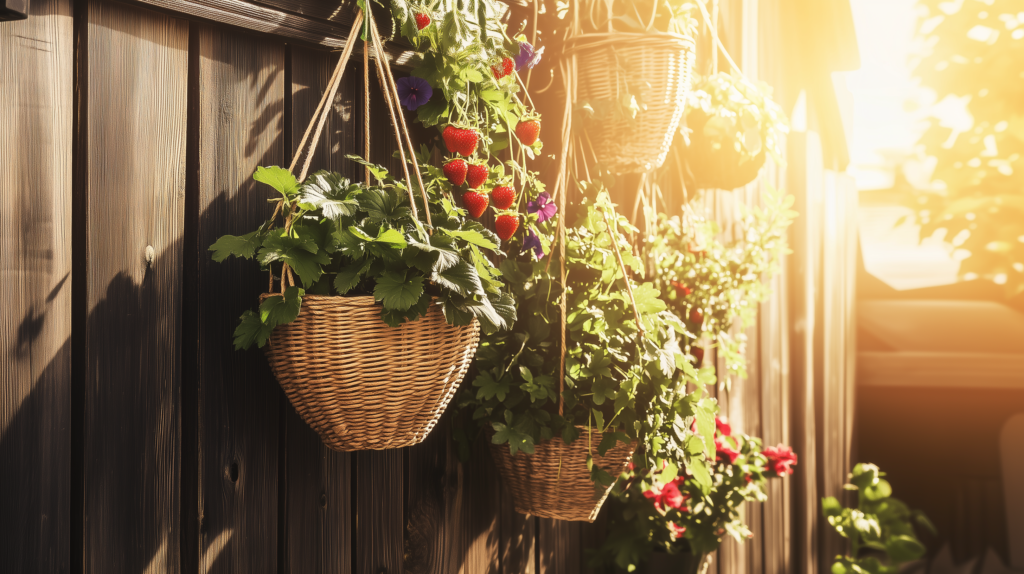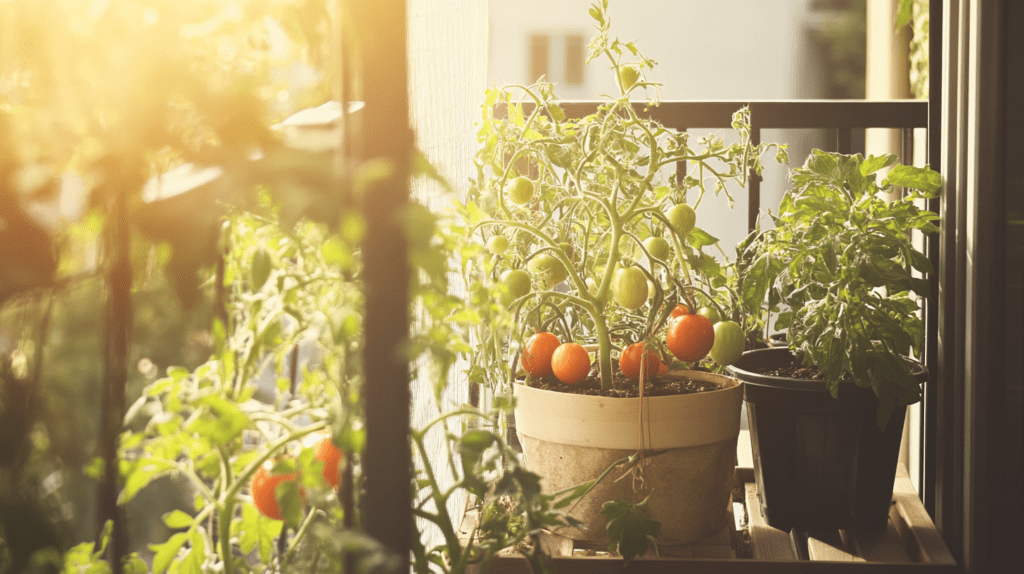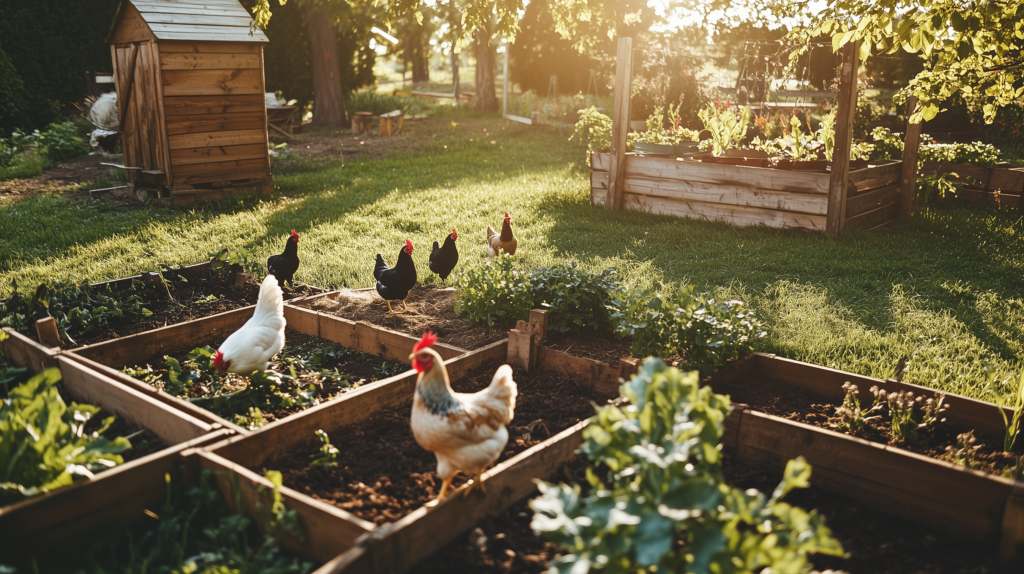This post may contain affiliate links, including those from Amazon Associates. If you make a purchase through these links, I may earn a commission at no additional cost to you. Learn more about our affiliate policy.
I’ll be the first to admit – when I started growing my own food, I thought I needed sprawling garden beds and endless space to make it work. But as I quickly learned, backyard homesteading is about working with what you have, and sometimes, that means getting creative with space.
That’s where creative vertical gardening comes in.
If you’ve ever felt limited by a small backyard, a patio, or even just a corner of your homestead, vertical gardening is a game-changer.
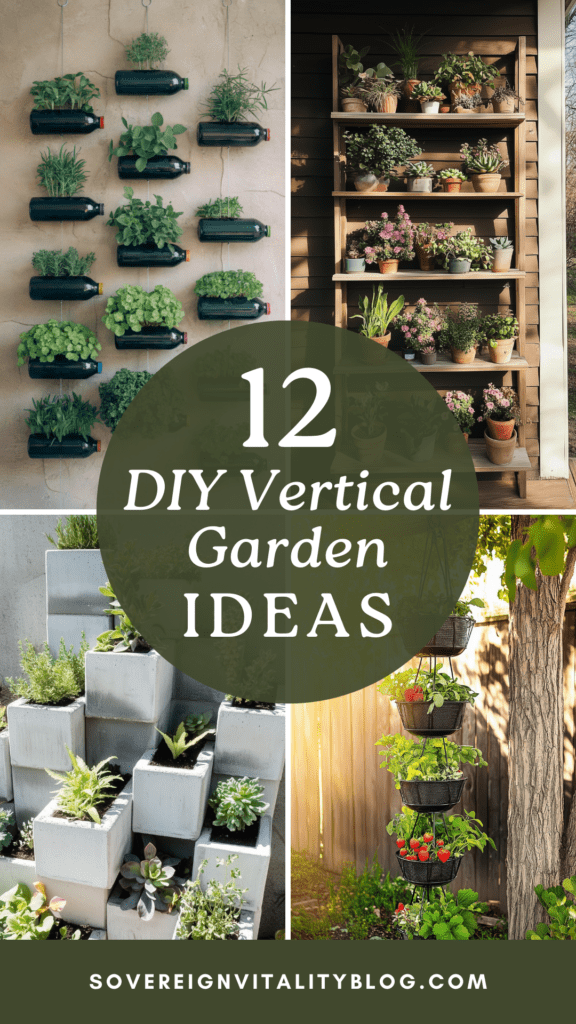
By growing up instead of out, you can maximize your harvest, make your space more beautiful, and even cut down on weeding and maintenance. And the best part? You don’t need a green thumb or an elaborate setup to get started.
These DIY vertical garden ideas will help you make the most of every inch you have available whether you have a small backyard, patio or apartment balcony. They’re beginner-friendly, budget-conscious, and perfect for backyard homesteaders who want to grow more with less space.
1. Pallet Vertical Herb Garden
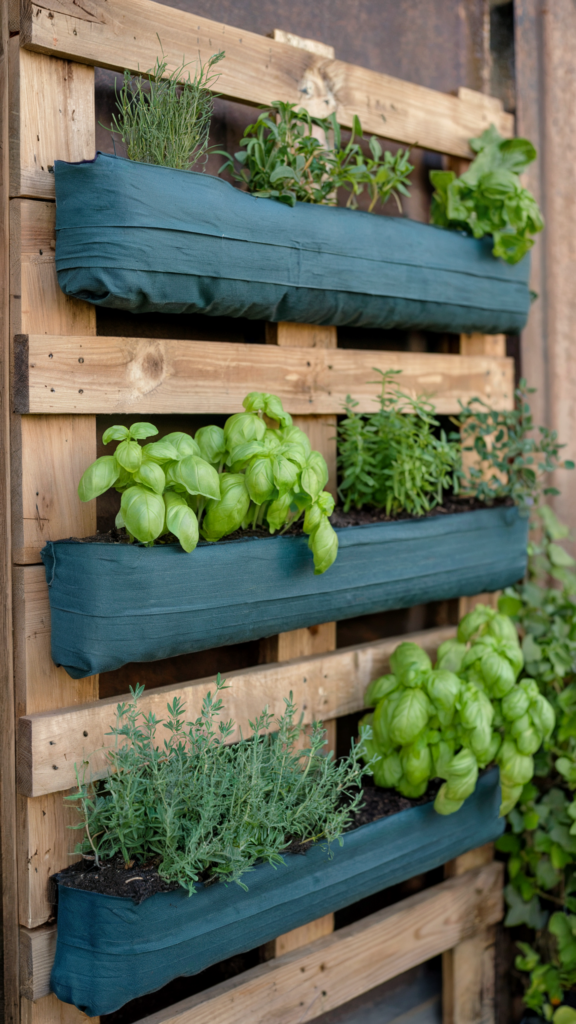
If you have an old wooden pallet lying around, don’t toss it – turn it into a space-saving vertical herb garden! This DIY project is an easy, rustic way to grow fresh herbs while keeping them off the ground. It’s perfect for backyard homesteaders who want a functional yet charming addition to their space.
Best for: Basil, thyme, parsley, mint, oregano, and other shallow-rooted herbs.
How to Make It:
- Find a sturdy wooden pallet—check local stores, garden centers, or Craigslist for freebies.
- Sand down rough edges and apply a natural wood sealant for durability.
- Attach landscape fabric to the back and bottom of each row to hold soil in place.
- Fill the openings with nutrient-rich soil and plant your favorite herbs.
- Secure the pallet against a wall or fence, or use strong brackets to keep it upright.
DIY Tip: To prevent soil from spilling out, tuck the landscape fabric securely inside each planter section, and don’t overwater—herbs prefer well-draining soil.
2. Hanging Gutter Garden
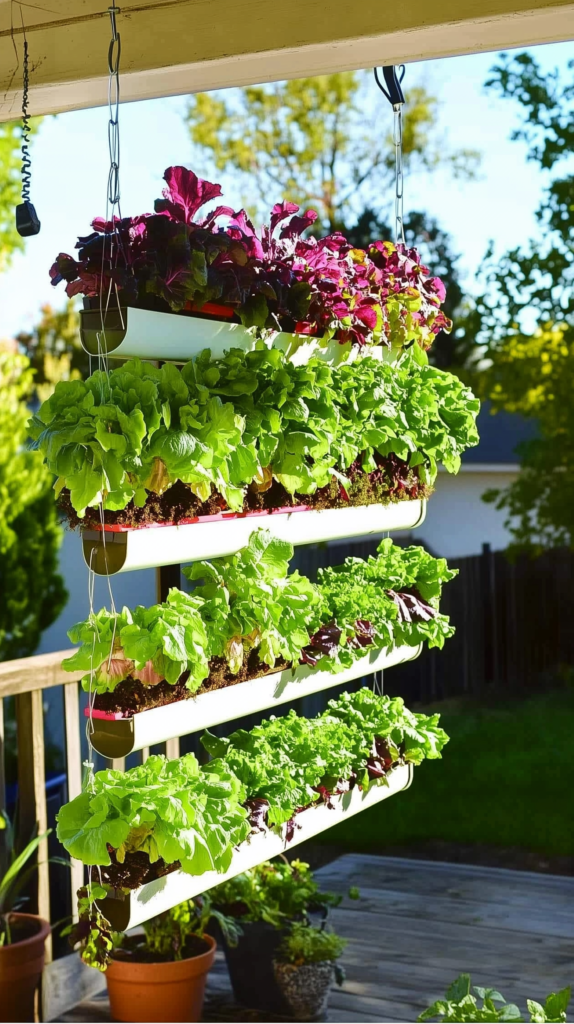
Old rain gutters might not seem like gardening material at first, but they make the perfect shallow planters for a vertical garden. By mounting them on a fence or wall, you can create a multi-tiered growing space that’s both practical and visually appealing. Plus, it’s an excellent way to repurpose materials that might otherwise go to waste.
Best for: Lettuce, strawberries, spinach, arugula, and other shallow-rooted greens.
How to Make It:
- Find old or unused gutters – check salvage yards or home improvement stores for budget-friendly options.
- Cut them to your desired length and drill small drainage holes every few inches to prevent water buildup.
- Secure the gutters to a fence, wall, or wooden posts using strong brackets or hooks.
- Fill each gutter with quality potting soil and plant your chosen greens or berries.
- Water lightly and ensure the gutters are slightly tilted for proper drainage.
DIY Tip: If you want a more decorative look, paint the gutters with a weather-resistant, non-toxic paint before hanging them.
Here’s the full tutorial from Garden Answer:
3. Ladder A-Frame Vertical Garden
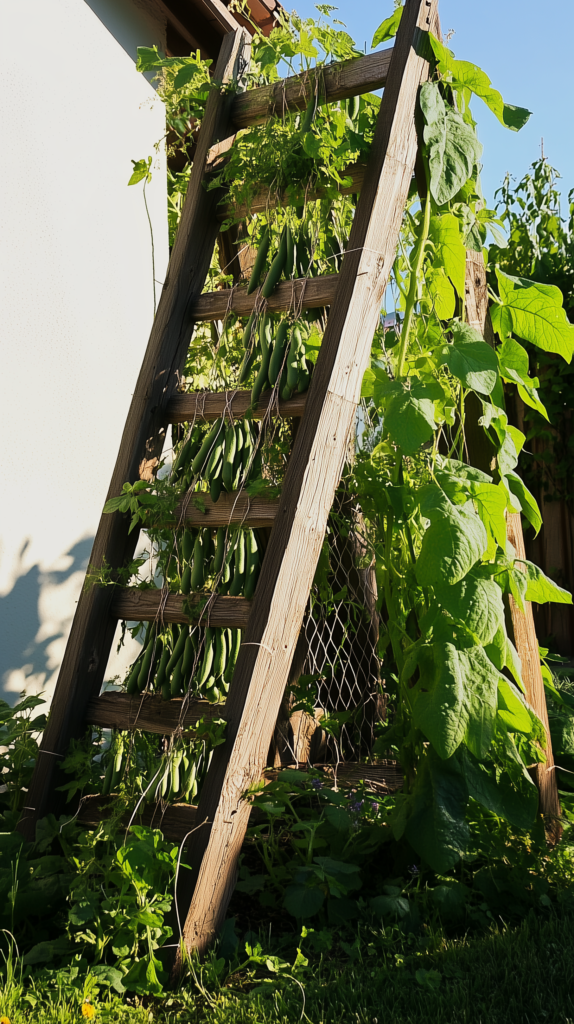
A repurposed ladder makes the perfect A-frame garden, allowing you to grow climbing vegetables on one side and use the other for potted plants or hanging baskets. Its natural stability means no additional framing is needed, and you can easily move it around your backyard for optimal sunlight exposure.
Best for: Climbing vegetables (beans, peas, cucumbers), strawberries, leafy greens, and herbs.
How to Make It:
- Find a sturdy, old wooden or metal ladder – A foldable, double-sided ladder works best.
- Set up the A-frame – Open the ladder into an A-shape and secure it with brackets or stakes if needed.
- Attach climbing support – On one side, add garden netting, wire mesh, or twine for vining plants to climb.
- Create growing spaces – Use the ladder rungs to support wooden planks, planter boxes, or fabric grow bags for herbs and leafy greens.
- Add hanging baskets – Secure hooks on the top rung for hanging strawberries or cascading flowers.
- Position and plant – Place the ladder in a sunny spot and start planting!
DIY Tip: For a mobile option, attach wheels to the base of the ladder for easy repositioning throughout the growing season.
4. Shoe Organizer Hanging Garden
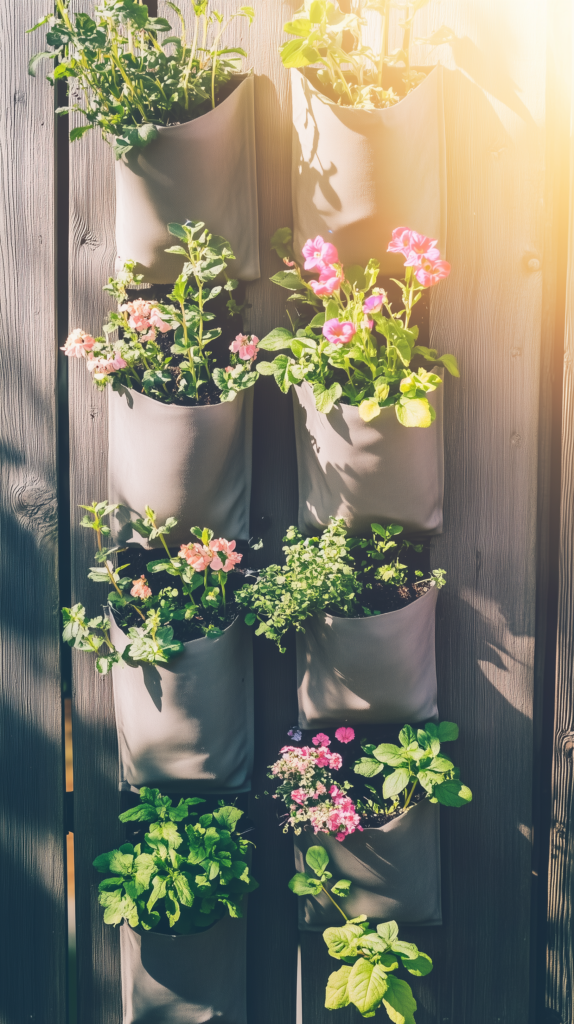
If you’re short on space but still want a thriving garden, a fabric shoe organizer is an easy, affordable solution. With its built-in pockets, it’s perfect for growing herbs, flowers, or even strawberries—plus, it can be hung on a fence, wall, or balcony railing. It’s one of the simplest ways to create a vertical garden without any heavy construction.
Best for: Herbs, strawberries, flowers, and small leafy greens.
How to Make It:
- Choose a sturdy, breathable fabric shoe organizer—canvas works best.
- Use a hole punch or scissors to create small drainage holes at the bottom of each pocket.
- Hang the organizer on a fence, wall, or door using hooks, nails, or a wooden frame.
- Fill each pocket with lightweight potting soil and plant your chosen herbs or flowers.
- Water carefully, ensuring excess moisture can drain properly.
DIY Tip: For an even longer-lasting setup, line the pockets with coconut coir or landscape fabric before adding soil to help retain moisture while allowing proper drainage.
5. Stacked Crate Garden
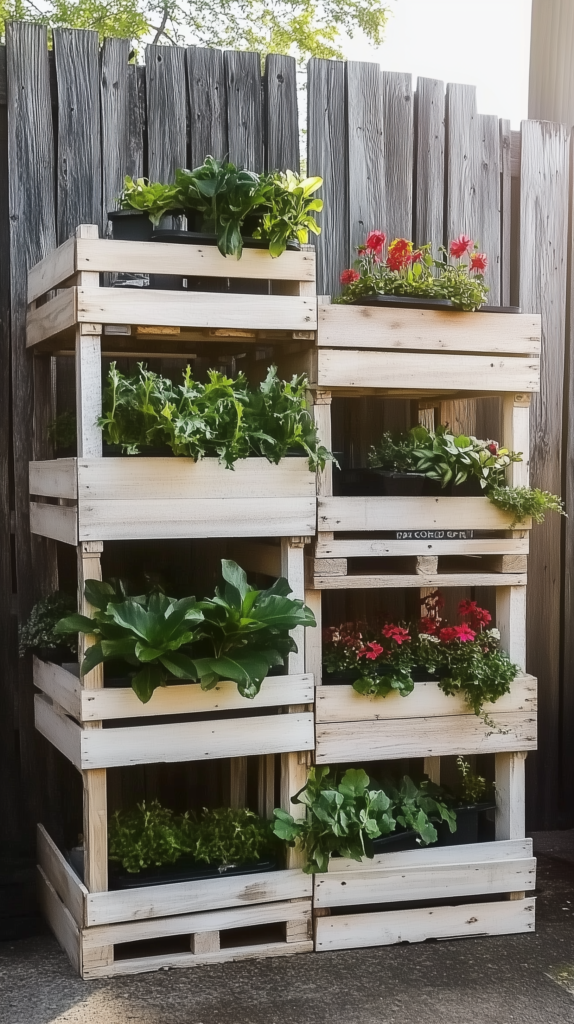
Stacking crates is an effortless way to create a tiered vertical garden while keeping your plants organized and easy to access. Whether you use wooden apple crates or sturdy plastic ones, this setup allows for multiple layers of growing space without taking up much room. Plus, it’s a great way to repurpose old crates into something functional and beautiful.
Best for: Leafy greens, strawberries, flowers, and small herbs.
How to Make It:
- Gather wooden or plastic crates of the same or varying sizes.
- Drill small drainage holes in the bottom of each crate if they don’t already have them.
- Remove some of the crate planks to make room for plants to grow and watering.
- Stack the crates in a tiered formation, placing the largest at the bottom for stability.
- Secure them with zip ties, screws, or brackets to prevent shifting.
- Fill each crate with nutrient-rich soil and plant your chosen greens or flowers.
DIY Tip: For added durability, use weatherproof stain on wooden crates or line them with landscape fabric to prevent soil loss and extend their lifespan.
6. Hanging Wire Basket Tower

A hanging wire basket tower is a simple, space-saving way to grow fresh greens, herbs, or flowers without taking up ground space. By stacking wire baskets vertically and suspending them from a sturdy frame, you create a cascading garden that allows for excellent airflow and easy harvesting. This project is perfect for backyard homesteaders looking for an elegant yet functional vertical gardening solution.
Best for: Lettuce, herbs, strawberries, flowers, and small leafy greens.
How to Make It:
- Gather materials – Find 3–5 sturdy wire baskets of varying sizes, strong chain or rope, and S-hooks.
- Prepare the baskets – Line them with coconut coir or landscape fabric to hold soil while allowing drainage.
- Attach the baskets – Use the chain or rope to connect the baskets in a vertical stack, securing them with S-hooks.
- Hang the tower – Suspend the basket tower from a strong hook attached to a pergola, tree branch, or metal stand.
- Fill with soil and plants – Use lightweight potting soil and plant herbs, strawberries, or cascading flowers in each basket.
- Water regularly – Since the baskets allow airflow, they can dry out quickly—ensure consistent watering for healthy growth.
DIY Tip: For a modern rustic look, use black metal baskets with natural coconut liners and stagger the heights of the baskets for a layered effect.
Elevate your outdoor space with the Karlliu 14″ Hanging Flower Baskets—a set of four durable metal wire planters with breathable coco liners for optimal water retention. Rust-resistant and stylish, they’re perfect for patios, gardens, and balconies, blending beauty with function.

7. Repurposed Bookshelf Planter
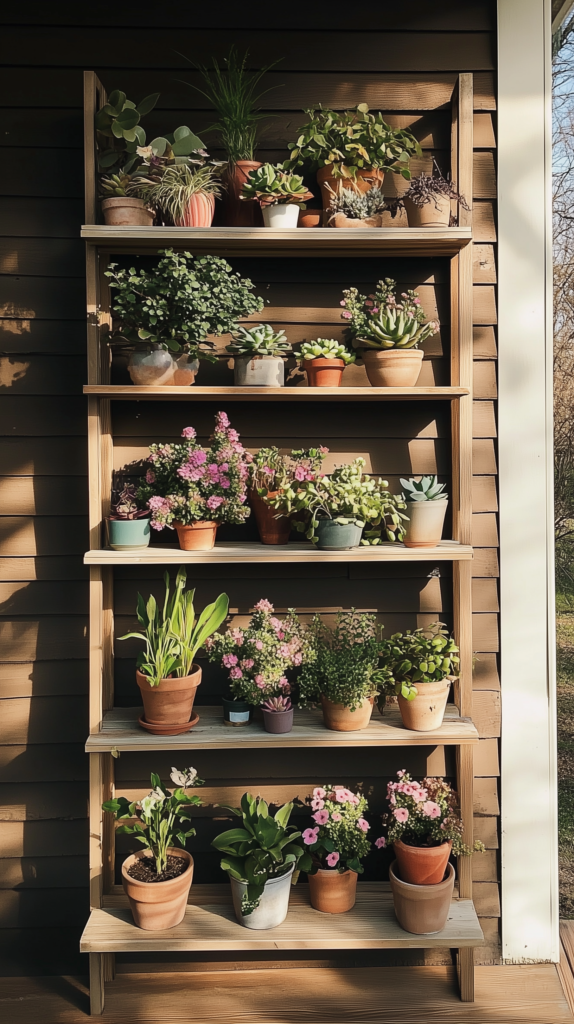
An old bookshelf can easily be transformed into a stylish vertical garden to hold potted plants, making it a beautiful and functional addition to any backyard homestead. This setup keeps plants organized, saves space, and gives a second life to unused furniture—all while creating a visually appealing green display.
Best for: Flowers, succulents, small vegetables, and herbs.
How to Make It:
- Find an old bookshelf – Check thrift stores, garage sales, or repurpose one you already have.
- Sand and seal the wood – Use an outdoor-safe stain or waterproof sealant to protect it from weather exposure.
- Reinforce the structure – If needed, add brackets or extra screws to ensure stability, especially for heavier pots.
- Drill drainage holes – Create small holes in each shelf to prevent water from pooling.
- Arrange potted plants – Place terracotta, ceramic, or plastic pots on each shelf, organizing by plant type and sunlight needs.
- Secure against a wall – Attach the bookshelf to a sturdy wall or fence to prevent tipping, especially in windy conditions.
DIY Tip: For added charm, mix and match pot styles, and consider adding hanging planters from the top shelf for a cascading effect.
8. Hanging Mason Jar Garden
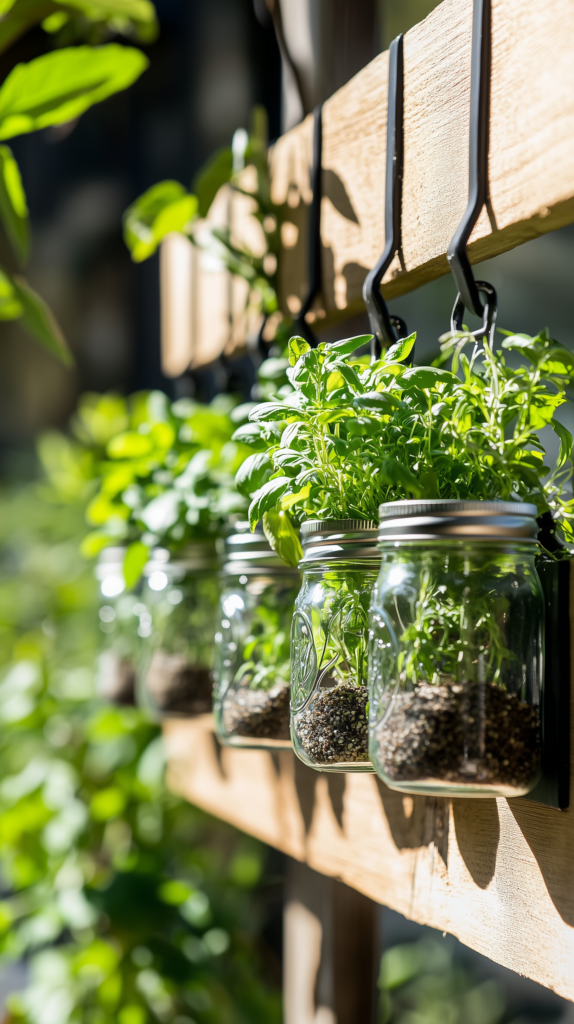
A hanging mason jar garden is a simple yet charming way to grow fresh herbs or succulents while adding a rustic touch to your backyard. By attaching jars to a wooden board, you create a functional and decorative vertical garden that fits perfectly on a fence, wall, or even indoors near a sunny window.
Best for: Herbs, succulents, and microgreens.
How to Make It:
- Gather mason jars, a sturdy wooden board, and metal hose clamps or brackets.
- Secure the jars to the board using the clamps, spacing them evenly.
- Drill small drainage holes in the bottom of each jar or add a layer of small pebbles for drainage.
- Fill the jars with a well-draining potting mix and plant your chosen herbs or succulents.
- Mount the board on a wall or fence in a sunny location.
DIY Tip: For a farmhouse-style look, stain or paint the wooden board before attaching the jars, and use chalk labels to identify each plant.
9. Upcycled Ladder Garden

If you have an old wooden ladder gathering dust, turn it into a unique vertical garden! By leaning it against a wall and using each step as a plant shelf, you create a space-efficient, rustic display that works beautifully for small plants and compact veggies. Plus, it’s an easy way to repurpose something you might already have.
Best for: Herbs, flowers, and compact vegetables like lettuce or radishes.
How to Make It:
- Find an old wooden ladder and sand it down to remove any rough edges.
- Apply a weatherproof sealant or paint if using it outdoors.
- Lean the ladder securely against a wall, fence, or trellis.
- Place potted plants on each step, arranging by size and sunlight needs.
- Use zip ties, brackets, or wire to secure pots in place to prevent tipping.
DIY Tip: For added stability, attach the top of the ladder to the wall with a hook or bracket, especially in windy areas.
10. Hanging Bottle Garden
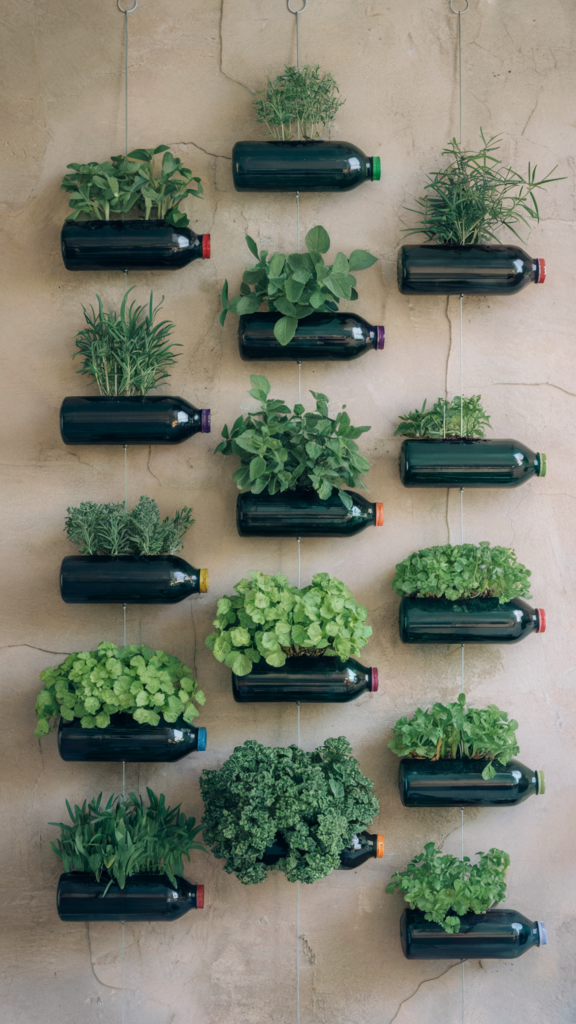
Repurposing plastic bottles into a wall-mounted vertical garden is an eco-friendly and space-saving way to grow herbs and small greens. By cutting openings into bottles and hanging them horizontally on a sturdy wall or fence, you create a modern, functional garden that’s perfect for small spaces. This simple DIY project is great for homesteaders looking to reduce waste while growing fresh produce.
Best for: Herbs, small leafy greens, and strawberries.
How to Make It:
- Collect plastic bottles – 2-liter soda bottles work best for this project.
- Cut openings – Slice a wide rectangular opening along the side of each bottle for planting.
- Drill drainage holes – Add small holes at the bottom to prevent water buildup.
- Thread hanging wire – Use string, twine, or wire to thread through holes near the bottle caps and bottoms.
- Secure to a wall or fence – Attach the bottles in staggered rows to maximize space and create a cascading effect.
- Fill with soil and plants – Use lightweight potting soil and plant herbs or small greens.
DIY Tip: Angle the bottles slightly downward so excess water can drip from one to the next, creating a self-watering system.
11. DIY Cinder Block Planter Wall
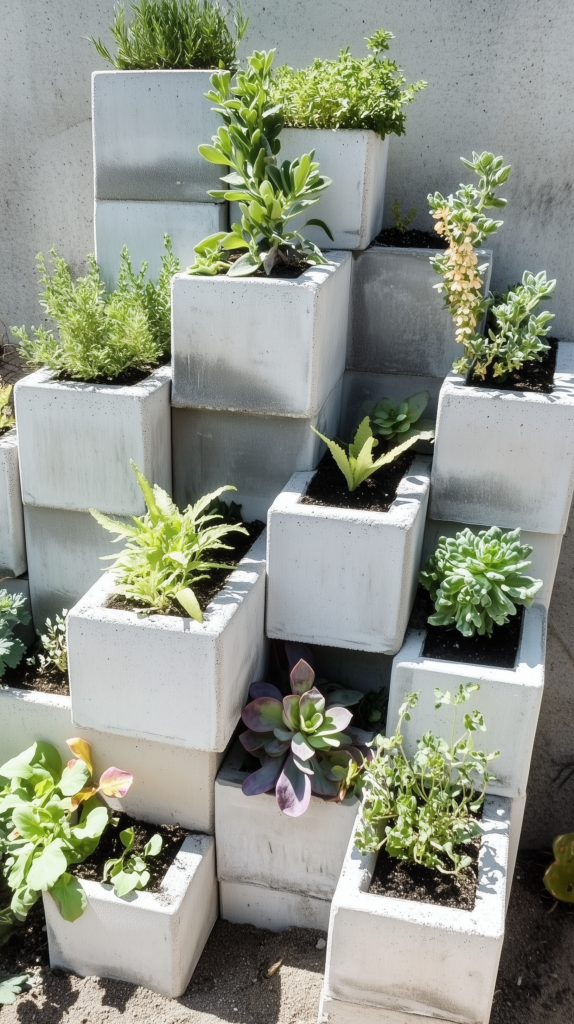
Cinder blocks aren’t just for construction—they make an excellent foundation for a sturdy, modular vertical garden. With their built-in planting pockets, you can create a unique, geometric display that’s both functional and visually appealing. Plus, they’re durable and require minimal maintenance, making them a great choice for backyard homesteaders.
Best for: Herbs, succulents, and flowers.
How to Make It:
- Gather cinder blocks and decide on a design—stack them in a pyramid, staggered pattern, or wall formation.
- Arrange the blocks so that some of the openings face upward to serve as planters.
- Fill the open spaces with high-quality potting soil and plant your chosen herbs or flowers.
- For stability, use mortar or landscape adhesive if stacking more than two levels high.
- Water regularly and adjust the layout as needed to suit your space.
DIY Tip: Paint or whitewash the cinder blocks for a decorative touch that complements your backyard aesthetic, or stencil on patterns for added charm.
12. Hanging Basket Wall Garden
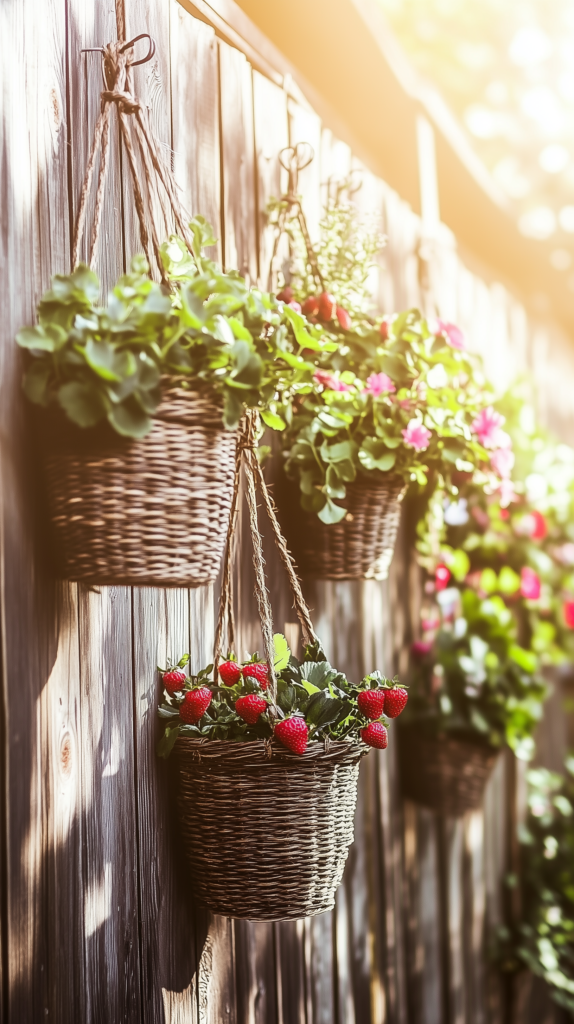
A hanging basket wall garden is a beautiful and practical way to grow flowers, cascading plants, or even strawberries without taking up valuable ground space. By attaching baskets to a fence or wall, you can create a lush vertical display that adds charm to any backyard homestead. Plus, this setup allows for easy access and maintenance.
Best for: Flowers, strawberries, and cascading plants like trailing herbs or vines.
How to Make It:
- Choose sturdy hanging baskets with strong metal or wooden frames.
- Attach hooks or brackets to a fence, exterior wall, or wooden panel.
- Line each basket with coconut coir or a breathable liner to retain moisture while allowing proper drainage.
- Fill baskets with high-quality potting soil and plant your chosen flowers or edible plants.
- Water regularly, ensuring the soil stays moist but not overly saturated.
DIY Tip: Arrange baskets at varying heights to create visual interest and maximize growing space, especially if incorporating cascading plants like strawberries or trailing herbs.
Budget-Friendly & Stylish Vertical Gardening Options
Don’t want to DIY? I get it—sometimes, you just want a simple, stylish solution without the extra work. Thankfully, there are plenty of ready-made vertical gardening options that look great and won’t break the bank. Here are some budget-friendly options to elevate your backyard garden with minimal effort.
Enhance your space with the ShopLaLa Wooden Wall Planter—a beautifully crafted, space-saving vertical garden ideal for indoor or outdoor use. Made from high-quality, weather-resistant wood, it offers a stylish, natural way to display plants, herbs, or flowers while maximizing space with intentional design.

The LINZINAR 4-Tier Metal Plant Stand is a space-saving, durable display for indoor and outdoor greenery. With a sleek, rust-resistant design, it holds up to five potted plants, adding elegance and vitality to any home or garden space.

The Amazing Creation Stackable Planter is a space-saving, vertical garden solution perfect for growing herbs, vegetables, succulents, and flowers indoors or outdoors. Made of durable, lightweight plastic, it features five stackable tiers, accommodating up to 15 plants with ease.

Conclusion
Vertical gardening is one of the easiest ways to maximize space, boost productivity, and add beauty to your backyard homestead. Whether you’re repurposing old materials, upcycling everyday items, or investing in budget-friendly solutions, there’s a vertical garden idea for every skill level and budget. Start small with a simple pallet herb garden or hanging baskets, and expand as you gain confidence. No matter which method you choose, growing up instead of out will help you make the most of your space—while keeping your garden both functional and visually stunning.

